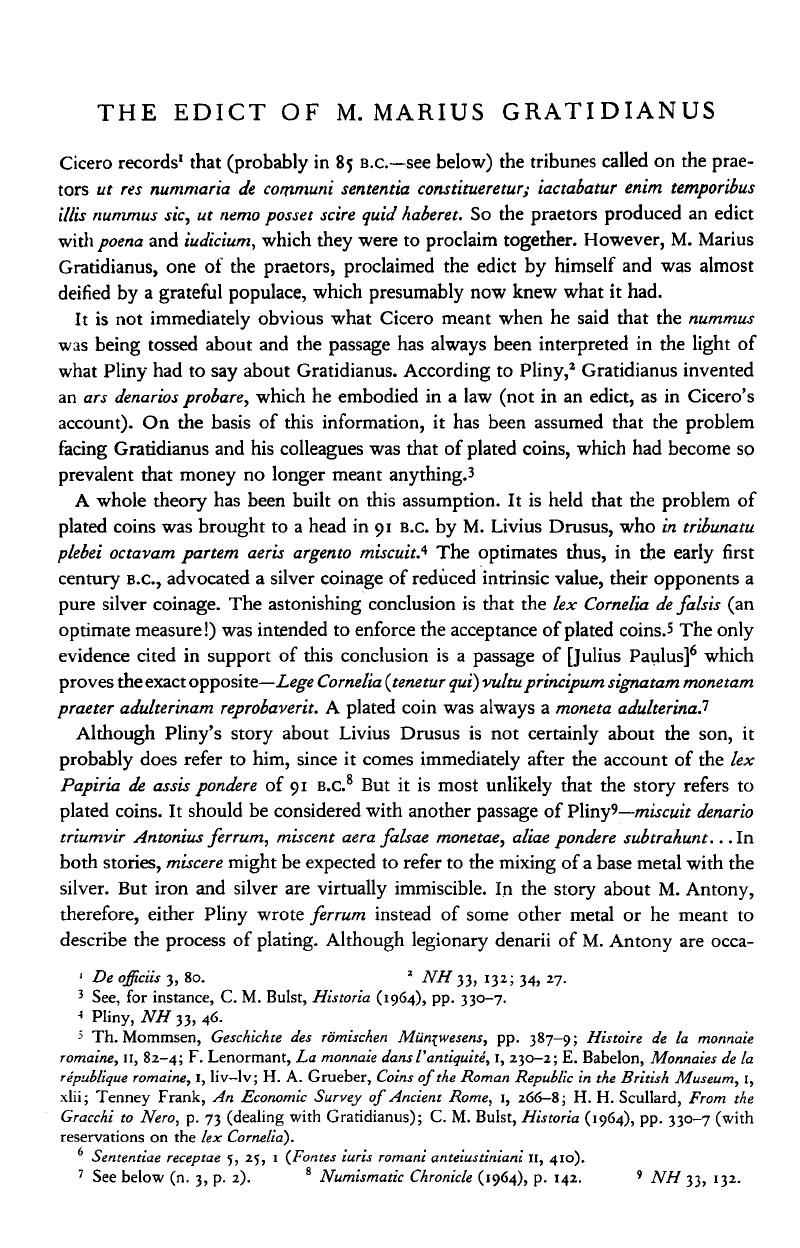Article contents
The Edict of M. Marius Gratidianus
Published online by Cambridge University Press: 24 January 2019
Abstract

- Type
- Other
- Information
- Proceedings of the Cambridge Philological Society (Second Series) , Volume 14: New Series , 1968 , pp. 1 - 4
- Copyright
- Copyright © The Author(s). Published by Cambridge University Press 1968
References
Page 1 note 1 De officiis 3, 80.
Page 1 note 2 NH33, 132; 34, 27.
Page 1 note 3 See, for instance, C. M. Bulst, Historia (1964), pp. 330—7.
Page 1 note 4 Pliny, NH33, 46.
Page 1 note 5 Th. Mommsen, Geschichte des römischen Münwesens, pp. 387—9; Histoire de la monnaie romaine, II, 82—4; F. Lenormant, La monnaie dans iantiquite, I, 230—2; E. Babelon, Monnaies de la republique romaine, I, liv—lv; H. A. Grueber, Coins ofthe Roman Republic in the British Museum, I, xlii; Tenney Frank, An Economic Survey of Ancient Rome, 1, 266-8; H. H. Scullard, From the Gracchi to Nero, p. 73 (dealing with Gratidianus); C. M. Bulst, Historia (1964), pp. 330—7 (with reservations on the lex Cornelia’).
Page 1 note 6 Sententiae reeeptae 5, 25, 1 (Fontes iuris romani anteiustiniani II, 410).
Page 1 note 7 See below (n. 3, p. 2).
Page 1 note 8 Numismatic Chronicle (1964), p. 142.
Page 1 note 9 NH33, 132.
Page 1 note 1 Numismatic Chronicle (1843-4), pp. 67-8.
Page 2 note 2 Invalidation on religious grounds—Cicero, de legibus 2, 31; Asconius 68-69 c ; invalidation because of contravention of lex Caecllia et Didia—Cicero, de domo 41 and 50; see also Cicero, de legibus 2, 14; Diodorus 37, 10.
Page 2 note 3 Numismatic Chronicle (1968), pp. 55-9. For debasement of the coinage by the State, a different matter altogether, seeJRS (1964), pp. 29-32 with Zonaras 8, 26, 14.
Page 2 note 4 Op. cit. (n. 5, p. 1 above).
Page 2 note 5 RE, XVII , 1415.
Page 2 note 6 A. Degrassi, Inscriptiones latinae liberae rei publicae, 1023; see also Plautus, Persa 437; Cicero, in Verrem ii, 3, 181.
Page 2 note 7 A. Degrassi, Inscriptiones latinae liberae rei publicae, 1001.
Page 2 note 8 RE,xvn, 1441.
Page 2 note 9 RE,xiv, 1826.
Page 2 note 10 A. Degrassi, Inscriptiones latinae liberae rei publicae, 1004.
Page 3 note 1 JRS (1964) , pp. 29-32.
Page 3 note 2 L. C. West and A. C. Johnson, Currency in Roman and Byiantine Egypt, pp. 7—12.
Page 3 note 3 Official and unofficial rates side by side—The Collection ofAncient Greek Inscriptions in the British Museum, III, 481 (Ephesus, A.D. 104); variety of unofficial rates—OGIS,484 (Pergamum, early second Century A.D.); official rate of 1 denarius to 16 asses—IGRR,iv, 915 (Cibyra, A.D. 74); IG,xii, 5, 659 and 663-5 (Syros, late second Century A.D.); unofficial rate of 1 denarius to 18 asses— Inschriften von Pergamon 374, D (Pergamum, reign of Hadrian).
Page 3 note 4 See T. V. Buttrey, The American Numismatic Society Museum Notes (1957), p. 57.
Page 3 note 5 If aeraria ratio is taken to refer to the exchange rate between silver and bronze, a reasonable meaning can be assigned to Cicero, pro Quinctio 17—Cum pecuniam C. Quinctius P. Scapulae debuisset, per te, C. Aquili, decidit P. Quinctius quid liberis eius dissolveret. Hoc eo per te agebatur quodpropter aerariam rationem non satis erat in tabulis inspexisse quantum deberetur, nisi ad Castoris quaesisses quantum solveretur. The use of the official rate of exchange seems to have been universal in Computing interest, though not necessarily in paying it (see notes 2 and 3, above).
Page 3 note 6 For a dishonest nummularius (here a banker) see Suetonius, Galba 9.
Page 4 note 1 Commonly and erroneously called Senate and Equites.
- 4
- Cited by




